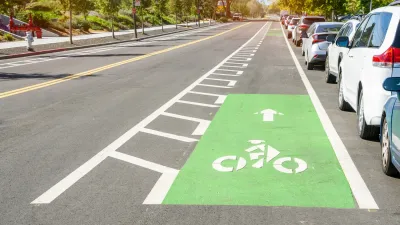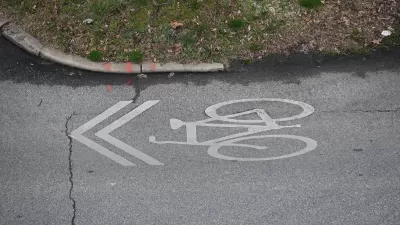After a recent death on the White Oak Trail, Houston bike advocates say closure markers on the city’s bike trails are often inconsistent and hard to see, posing a danger for cyclists at night.

Houston bike activists are calling on the city to improve safety on bike trails, particularly when it comes to marking trail closures and construction areas, after the death of a cyclist last week, reports Dug Begley in the Houston Chronicle. Matthew Ledvina died after being found sprawled in the middle of the White Oak Trail with his bicycle and orange construction netting nearby.
While the cause of Ledvina’s death is as yet unclear, other Houston cyclists say trail closures are often poorly marked and difficult to see at night. “Tuesday evening, five days after the crash, the netting had been adorned with strips of yellow caution tape and a homemade sign warning of the danger.” Local cyclists and walkers were observed ignoring the netting to avoid the detour.
Begley adds that “Wednesday, after cyclists raised concerns and the city and county were asked about the design of the closing, workers placed reflective warning barriers commonly used on streets along the trail as an extra measure where the path is blocked.”
Begley points out that there are no standardized regulations for closures or detours on bike and pedestrian trails, with only a brief mention of signage for bike trail closures in the city’s design manual. “‘There seems to be a complete dearth of regulations for signage, warnings and other laws,’ said Charlie Thomas, a Houston lawyer who often represents cyclists injured in crashes, as part of the national Bike Law Network.”
FULL STORY: White Oak Trail cycling death prompts questions on trail closings

Maui's Vacation Rental Debate Turns Ugly
Verbal attacks, misinformation campaigns and fistfights plague a high-stakes debate to convert thousands of vacation rentals into long-term housing.

Planetizen Federal Action Tracker
A weekly monitor of how Trump’s orders and actions are impacting planners and planning in America.

In Urban Planning, AI Prompting Could be the New Design Thinking
Creativity has long been key to great urban design. What if we see AI as our new creative partner?

King County Supportive Housing Program Offers Hope for Unhoused Residents
The county is taking a ‘Housing First’ approach that prioritizes getting people into housing, then offering wraparound supportive services.

Researchers Use AI to Get Clearer Picture of US Housing
Analysts are using artificial intelligence to supercharge their research by allowing them to comb through data faster. Though these AI tools can be error prone, they save time and housing researchers are optimistic about the future.

Making Shared Micromobility More Inclusive
Cities and shared mobility system operators can do more to include people with disabilities in planning and operations, per a new report.
Urban Design for Planners 1: Software Tools
This six-course series explores essential urban design concepts using open source software and equips planners with the tools they need to participate fully in the urban design process.
Planning for Universal Design
Learn the tools for implementing Universal Design in planning regulations.
planning NEXT
Appalachian Highlands Housing Partners
Gallatin County Department of Planning & Community Development
Mpact (founded as Rail~Volution)
City of Camden Redevelopment Agency
City of Astoria
City of Portland
City of Laramie





























